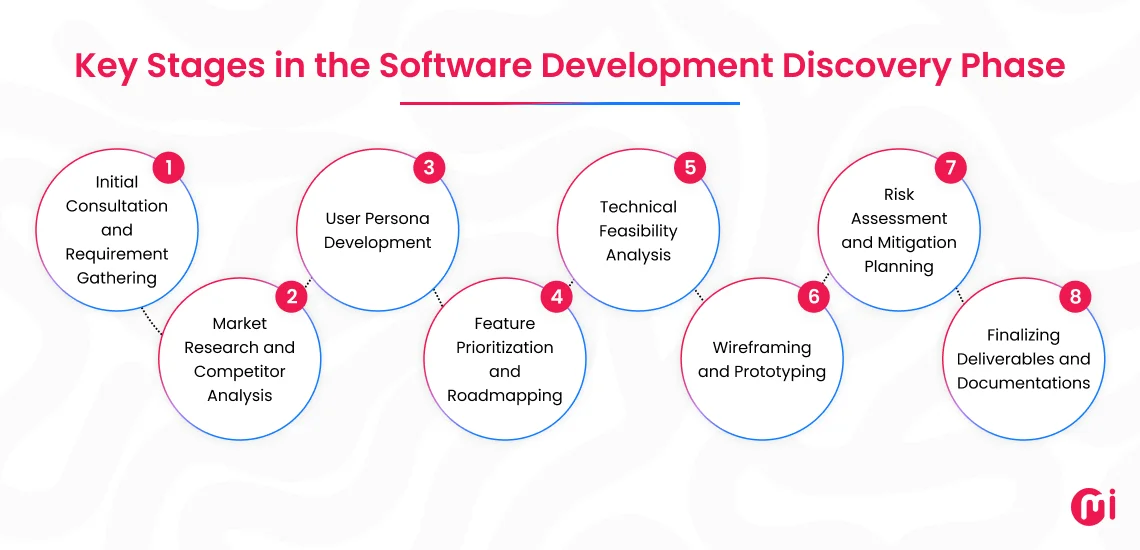Discovery Phase in Software Development: A Pivot For Your Project Success
- Software
- November 26, 2024
Planning for a software development on which your entire business would rely? The discovery phase of software development might be your project’s lifeline. Essential for setting clear objectives, understanding market needs, and mitigating risks, this discovery phase lays the groundwork for any software development project. Whether you’re a startup or an established company, neglecting this step can lead to costly missteps. Dive into the comprehensive blog to learn everything you need to know about the discovery phase in software development projects.
Did you know, as per the BCG survey, around 30% of technology development projects end up in the trap of budget overruns and delays?
Yes, that’s the thing! And the major reason behind this is poor software development planning and execution.
What if we say there’s a way to get out of this trap and avoid leading your software development project towards failure? The discovery phase led by tech industry experts is the key.
In this blog, we are going to explore everything you need to know about tech business failures, the importance of the software development discovery phase, stages, and an expert checklist to execute it effectively.
Common Reasons for Tech Business Failures
Running a business based on technology is an ambitious journey, but you may have to deal with many challenges. The fundamental oversight during the software development planning stage is one of the many primary reasons behind its failure. Apart from that, many reasons follow in the manner as mentioned below:
- Poor business model
- Lack of innovation and inspiration
- Working on a software product development solution that does not have a market
- The value prepositions for the users don’t seem intriguing
- Extreme usage of budget and delivery deadline
- Communication problems lead to project failure
- Lack of awareness of the gaps in the modules
- Endless scope creep
There are many more reasons as well. Luckily, the discovery phase in the software development lifecycle brings a ray of hope and lays the groundwork for the project’s long-term success.
What is the Discovery Phase of a Software Project?
The discovery phase in software development is a crucial stage of this lifecycle. It brings different business roles together to conduct market research, analyze the problem statement and opportunities, and set up project goals, scope, target audience, and document technical project requirements.
It’s a strategic phase that lays the groundwork for successful project execution by minimizing risks, aligning stakeholders, and ensuring the product meets market demands.
But it’s must to know that the discovery phase has two types and can be executed for different purposes, which includes:
- Extended Discovery: Suitable for big-budget software development projects that require multiple moving parts and long-term considerations.
- Technical Discovery: For projects that do not require long discovery phases, as it’s possible to do through Proof of Concept (PoC) development.
After knowing this, you also want to know the purpose of the software development discovery phase, which covers the DBMIC principle:
- DETERMINE business needs and goals for the product
- BUILD software architecture that meets business goals
- MITIGATE software development project budget overrun
- IDENTIFY potential risks coming in the path
- CREATE a strategic and clear software development roadmap
But do all software development projects have to go through the discovery phase? Nice question, isn’t it? Well, the next section has a better explanation for that.
When do you Need a Discovery Phase in Software Development?
The simple answer is: ALWAYS, but there’s a condition for some projects as they may require extra attention compared to others.
The answer also lies in what problems or confusions you’re experiencing at the moment; most of the cases include:
- The software idea requires validation
- The need for risk contradictions
- Budget constraints
- Demand for faster time-to-market without any compromises
- Complex software development project that has more competition in the market
- The software concepts promise to scale with time
- The scope of the software development project may change over time
- Lengthy software development project
- No clarity on user needs and preferences
- No room for errors

Why should you Consider the Discovery Phase in Software Development?
Discovery phase is a process of collecting and organizing project information that helps startups, influencers, or common people to prioritize features, determine their target audiences, and get a better understanding and direction for their final requirements.
If you see the software development statistics, it can reduce the overall project cost by 30% significantly.
This phase is a bridge between the theoretical concept and the realization of the project.
- In fixed-cost projects, the discovery phase is the best practice for initiating the project.
- In agile, the discovery phase helps to establish a broader vision, project scope, and an initial milestone-based plan for the project delivery.
To understand it even better, below we have listed the reasons why you should opt for the discovery phase before moving ahead with your software development:
1. For a Clear Understanding of the Software Development Project
Having a clear understanding of the software product you’re developing—particularly its scope—can significantly streamline the entire process and ensure all components fall into place seamlessly.
When stakeholders, technical experts, and consultants align on the product’s purpose and scope, it brings clarity to what needs to be developed and how the final solution will take shape.
This understanding isn’t just the result of brainstorming and group discussions but is also grounded in thorough market research and analysis.
It’s no coincidence that top brands like Starbucks, Apple Inc., McDonald’s, the LEGO Group, and P&G lead their industries. Their success stems from a precise grasp of their goals, processes, and customer expectations—starting from the very foundation.
2. To Identify Potential Risks Early in Development Process
The discovery phase of software development process is not just limited to market research, but many technical and financial analyses are also involved.
This helps to know the potential technical, financial, and operation risks associated with the project. So, you can be prepared for that and less likely to encounter surprises during development process.
3. To Avoid Unexpected Delays and Budget Overruns
When you have a clear scope and understanding of software development project requirements with associated risks and mitigation strategies, it becomes easier for you to estimate costs and timelines more accurately.
Using that, the discovery phase of software development enables you to build a detailed project plan, considering resources, timeline, and budget, so you can avoid unexpected delays or costs during the development cycle.
4. To Create a Strategic Roadmap for Success
When your software development concept is clearly defined and the final product vision is well-scoped, the discovery phase naturally paves the way for a detailed roadmap that outlines every step of the project.
This strategic approach not only helps your dedicated software development team deliver high-quality software on time and within budget but also significantly increases the likelihood of the project’s success.
Wondering how a software product could benefit your business? Check out this comprehensive software product development guide for insights on benefits, steps, methodologies, challenges, and trends.
Key Stakeholders Involved In Software Development Discovery Phase
Discovery phase of software development requires the involvement of both the business and development teams. Below, we have mentioned roles that take part in the software development discovery phase:
- Project Sponsor/Customer: Provide funding for the project and share their goals, priorities, and expectations for the software.
- Product Owner: Responsible for representing the client’s interests, defining requirements, and ensuring the product aligns with the business objectives.
- Business Analyst: Business and technical experts who gather and analyze requirements, ensuring alignment with the project goals.
- Tech Leads/Software Architects: Evaluate the technical feasibility of the project, recommend the best technologies, and define the software architecture.
- Development Team Representatives: Provide their tech expertise insights into potential technical challenges and estimate the time and resources needed for implementation.
- Project Manager: Oversees the planning, execution, and coordination of the software development discovery phase, ensuring timelines and deliverables are met.

Key Stages in the Software Development Discovery Phase
The following are the eight main stages of the discovery phase of a software development project. Let’s look at each stage in greater detail.

STAGE 1: Initial Consultation and Requirement Gathering
The first stage of software development discovery phase is where you avail first consultation with the software development team. During your initial call, your software project objectives, existing challenges, goals, and software development requirements will be discussed. This discussion helps the development team to work further on the software project to get you the desired software development outcomes.
Read more: How to Choose a Software Development Partner That Aligns with Your Business Goals?
STAGE 2: Market Research and Competitor Analysis
The next step in software development discovery phase is conducting market research to find out similar software solutions and competitors that are doing best at their jobs, study the industry trends, and do the market gap analysis.
The insights that you receive from this stage shape the dynamics of your software development project and also raise the opportunity to define the unique value propositions of the product.
STAGE 3: User Persona Development
After learning about the current market opportunities and what you can give the best for your software development project, the next step of software development discovery phase involves user persona development. This also requires you to go back to your product vision and goals. This often helps businesses to get some clarity on the type of users that’d be using their product.
Competitor analysis plays a key role in creating detailed user personas to understand their needs, behaviors, and preferences.
Ensure that one persona is not enough to get to the ideal one; you may have to opt for multiple variations to get the best fit.
User persona often contains information about users, including their location, lifestyle, habits, pain points, experiences, interests, skills, brands they love, and everything that defines them.
STAGE 4: Feature Prioritization and Roadmapping
Multiple things you have to take care of, including goals, pain points it would be solving, budget, and timeline you have at the moment. Plus, you definitely don’t want to develop a full-fledged software in one go; you may want to check its feasibility, user acceptance, and a lot more things that bring business.
In this, you can start with MVP development by targeting core features and functionalities and investing a minimum amount of money for the idea validation.
You can also categorize features and use frameworks to include them based on their purposes and impact, which include:
- MoSCoW Method (Must-have, Should-have, Could-have, Won’t-have): A simple categorization approach.
- RICE Framework (Reach, Impact, Confidence, Effort): Considers the potential impact and effort required for each feature.
- Value vs. Complexity Matrix: Balances feature value against development complexity.
Once you select the features and their prioritization, go ahead with the product roadmap creation.
Your software development roadmap will be created by mentioning three things:
- Phases: Divides the development into stages like MVP development, beta release, and full release.
- Timelines: Plan delivery of each phase with realistic delivery schedules.
- Milestones: Highlights key deliverables and progress checkpoints.
This approach helps to get a blueprint of how much time and what your product will look like post each phase.
STAGE 5: Technical Feasibility Analysis
Once you get your software development plan, it’s time to find out the technical feasibility of the concept to avoid falling for technological and implementation traps.
Call it technical feasibility analysis or study—this includes the selection of the best-fit technology stack, scalability planning, software development methodology, necessary legacy, and third-party integrations—everything that lets your solution stay relevant to the audience for a long period of time.
During this stage, the hired tech leads for the software discovery phase can help a lot in terms of suggesting the best technology that goes well with your software development idea. Overall, this stage ensures that the project is achievable within the given constraints.
STAGE 6: Wireframing and Prototyping
Finalizing the technical details for software development is important, but how will your software solution look?
Wireframing and software product prototyping help answer this question during the discovery phase of a software project.
This is not the final UI version of the software solution, but you can think of it as an inspiration for what your concept would look like when it is completely developed.
This wireframing and prototyping helps stakeholders visualize the end product and provide feedback early in the process.
Want to know how wireframing is different from prototyping and mockups? Read our linked blog for better insights.
STAGE 7: Risk Assessment and Mitigation Planning
When considering a software development, it’s quite a humane thing to expect risks and delays in between. So, during this, you may expect potential risks, such as budget overruns, timeline delays, or possible technical challenges.
The technical team will also help you plan mitigation strategies to address these risks proactively.
STAGE 8: Finalizing Deliverables and Documentations
Lastly, documentation of all the findings take place that you’ve done and finalized in the discovery phase of software development.
This phase concludes with the documentation of findings, including user requirements, market insights, and the roadmap.
In the end of it, you can expect to get the below-mentioned documents:
- Project estimation
- Software requirement specification (SRS) documentation
- Risk management documentation
- Budget and resource allocation documentation
- Process documentation
By dividing the discovery phase of software development into various stages, teams can ensure a seamless transition into development. This structured approach not only minimizes risks but also enhances the chances of delivering a software product that meets user expectations and business objectives.
Essential Tips for a Successful Discovery Phase in Software Development
The discovery phase is an essential part of the software development services, which should be done with utmost transparency and clarity, which requires some special carefulness and practices as well. So, let’s have a look at things that require your utmost attention during the software development discovery phase:
- Try to dig deeper into its limitations along with the positive side of the modules, features, and technologies.
- Ensure that there’s transparency in communicating the expectations and requirements to stay aligned.
- Always ask for a timely progress report to ensure that it is going as expected.
- Conduct regular meetings to have brainstorming sessions and bring the best out of it.
PRO TIP: Take care of everything that we mentioned in this software development discovery stage above.

What Makes MindInventory Your Ideal Partner For Software Development Discovery Phase Project?
The discovery phase is a critical step in software development, as it defines the what, how, and why needed to achieve your business goals. At MindInventory, we recognize the importance of software development discovery phase, which is why we have a dedicated software development team specializing in discovery phase of software development. Our goal is to provide businesses with a foolproof project blueprint that lays the groundwork for success.
Our expert team comprises seasoned business analysts, project managers, technical leads, and UX researchers, all guided by our skilled CTO. Together, they ensure every solution we deliver is of the highest quality and tailored to meet your unique needs.
But don’t just take our word for it—our portfolio and long-standing client relationships speak volumes.
Take EnneaApp, a personality assessment and management platform that has trusted us since its discovery phase over 12 years ago. It continues to thrive, showcasing the value of our quality deliverables.
Also, consider Bhojdeals, Nepal’s #1 on-demand food delivery platform. From its discovery phase to its seamless delivery and ongoing support, the platform’s success and user-friendly experience are testaments to our commitment.
So, looking for the best software product development company to get your dream project to life? MindInventory is at your service!
FAQs About Software Development Discovery Phase
For the software development discovery phase, you’ll need clear project goals, inputs from the stakeholders, requirement documents -( if available,) and a lot of other things specific to the project that help to ensure the project aligns with user needs and business objectives.
Not every software development project necessarily requires a discovery phase. Its necessity depends on factors like project complexity, market competition, uniqueness of the concept, and the presence of a market gap. However, if your project aligns with these criteria, skipping the discovery phase can lead to significant challenges.
Without this crucial step, you risk misaligned project goals, scope creep, unexpected costs, and delays due to rework. Additionally, failing to fully understand the scope and requirements might result in a product that doesn’t meet user expectations or market demands, reducing its value or leading to outright failure. In short, the discovery phase acts as a safeguard to ensure your project is on the right track from the start.
The discovery phase lays the foundation for the software development project, preparing the team to transition seamlessly into the planning and design stages while ensuring better alignment with business goals.
On average, you can mark 1-6 weeks to finish the discovery phase of the software project. But this timeline can be different depending on the complexity of the software project.
Smaller projects might wrap up in a week or two, while larger or more complex initiatives might need months to fully flesh out all requirements. The speed of this phase is based on project complexity, size, and existing knowledge about the project.
Key deliverables of the software development discovery phase include the project scope document, user requirements, functional specifications, technical requirements, risk assessment, software development roadmap, and initial cost and time estimations.













